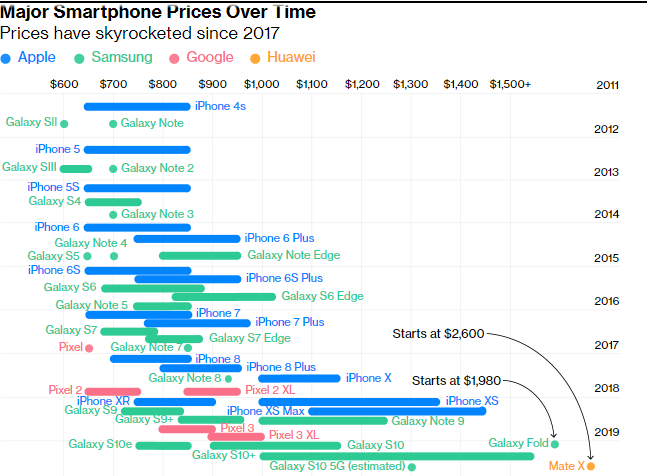There was a time when the average price of a flagship Android smartphone in the US used to be $600-$650. Those times are long gone, unfortunately, for reasons that are still yet to be determined. These days, affordable flagships such as the OnePlus 6T start at $550 in the US, while the price of a top-tier flagship smartphone has gone right to the $1,000 mark. Prices of each new flagship generation have increased dramatically. For example, the Galaxy S9 and the S9+ had launch prices of $720 and $840 respectively in the US, while the Galaxy S10 and the S10+ have launched for $900 and $1,000, representing a price increase of $180 and $160. Huawei has been equally guilty of this, as the Huawei Mate 20 Pro, for example, is a much more expensive phone than the two-generations-old Huawei Mate 9.
Why has this happened? One of the primary reasons has been Apple's high-profile calculated attempt to move the ASP (average selling price) of flagship smartphones to a higher point.
A report from Bloomberg notes that both Samsung and Huawei—the world's top two smartphone vendors—have followed and overtaken Apple's move to price new phones higher. The Apple iPhone XS and iPhone XS Max were the world's most expensive phones at launch, with the top variant of the XS Max costing $1,450. Samsung and Huawei have overtaken that $1,450 price point with the announcements of their foldable phones, the Galaxy Fold and the Mate X respectively. The Galaxy Fold costs $1,980, while the Huawei Mate X is an even more expensive proposition at €2,200. These are the most expensive smartphones of all time, discounting niche luxury brands.
Left: Samsung Galaxy Fold. Right: Huawei Mate X.
It seems Samsung and Huawei have opted to copy Apple's trend of trying to mitigate the negative effects of falling unit sales by increasing per-unit price and thereby earning more profit per device. New flagship phones are now generally more expensive than laptops, which is astonishing in itself.
Apple's move seemed to have initially paid off in 2017, as it reported record iPhone sales in the first fiscal quarter of 2018 after launching the iPhone X. However, the strategy has come back to haunt the company in the long run. Sales lost momentum as 2018 went on and then declined. Apple reported that iPhone revenue declined 15% in the fiscal first quarter from a year ago. According to Bloomberg, the weak sales are said to have inspired a "fire drill" at Apple, as the company introduces promotions to offset the rising prices. The company's COO has also said that it is "very aware" of concern about its product pricing.
Samsung and Huawei's move to sell their foldable phones at such a high price has the rationale of asking more money from early adopters to try to test the waters. These phones are not meant to be mainstream phones in either case, and consumer response will be the decisive factor to decide whether foldable phones will be the next big thing or an expensive gimmick.
Richard Yu, the CEO of Huawei's Consumer Group, has himself called the Mate X "very expensive." The Samsung Galaxy S10 5G is also likely to cost much more than $1,000, as the S10+ itself costs as much as $1,600 for the 12GB RAM/1TB storage variant.
IDC has stated that the average selling prices of smartphones worldwide increased to $575 in Q4 2018 from $542 a year ago.
The increase of flagship smartphone pricing in the US has had a chain effect on the rest of the smartphone market. Affordable flagships cost more than they used to. Budget and lower mid-range phones are slowly inching upwards in price. The increasingly high value of the dollar with respect to many emerging market currencies has led to staggering price increases of new flagship smartphone launches in markets such as India. It hasn't been all good, and we continue to see new developments in this field with concern.


